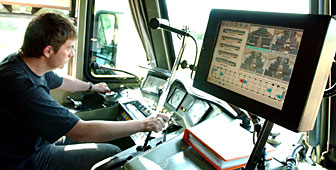Swiss railways draw line under crime

The Swiss Federal Railways is examining a raft of measures to combat violence, vandalism and fare-dodgers on its trains.
The debate over how to make the country’s railways safer has been re-ignited following the rape of a 16-year-old girl on a train near Zurich.
Last year more than 200 verbal or physical attacks on staff were recorded by the Swiss Transport Union, which believes the figure to be just the “tip of the iceberg”.
The union says the number of offenders being brought before the courts has more than doubled over the past five years.
However, the Swiss Federal Railways is quick to play down talk of an upsurge in crime on its trains.
“Statistically we have not seen an increase in acts of violence and vandalism on trains. You cannot talk about an explosion [of incidents],” spokesman René Baumann told swissinfo.
“Last week’s rape was dramatic and we will do everything we can to ensure there is no repeat. But we are not in the Wild West, and travelling by train remains safer than simply walking the streets of any Swiss city.
Wider social problem
Baumann contends that what is being seen on the railways mirrors a general tendency towards acts of violence and vandalism across society as a whole.
In an effort to combat a problem that is costing the railways SFr15 million ($10.4 million) a year, the authorities have initiated a series of pilot projects.
Closed circuit cameras have been installed on a train running between Lausanne and Geneva, and so far the results have been impressive.
“Since the spring of 2001, we have equipped six carriages with 24 cameras and this has led to an 80 per cent reduction in vandalism,” says Jean-Louis Scherz, a spokesman for the project.
“Since the cameras have been in place, we have not experienced an incident of sufficient gravity to have to call in the police.
“If a passenger feels threatened, they can also press an alarm button which alerts the driver. Since the start of the pilot project, the button has only been pressed once or twice, and always by mistake.”
Closed circuit cameras
At SFr450,000 ($312,000) for one train, the project, which is due to finish in the autumn, doesn’t come cheap. The authorities are currently calculating whether it will be financially viable to install cameras on other trains.
“At the moment, we are merely thinking about extending the scheme. It’s clear that if we fit them on several trains, the costs will decrease,” adds Scherz.
However, it is not just the costs that are giving the authorities a headache. The project is also being monitored by the country’s data protection watchdog to see whether the cameras violate Switzerland’s strict data protection laws.
“In Europe, we are seeing more and more video surveillance, but we mustn’t forget that this constitutes a massive intrusion of privacy and one’s freedom of movement,” said Kosmas Tsiraktopulos, spokesman for the Swiss Federal Data Protection Commissioner.
“Violence is a complex problem and video surveillance is not a cure-all – it must be accompanied by other measures.”
Private security guards
In another initiative, guards from the private security firm Securitas have been accompanying trains since April in the west of Switzerland between Geneva and Sion, Fribourg and Lausanne, and Neuchâtel and Lausanne.
Last year the Swiss Federal Railways also introduced a training programme for 1,700 employees on how to deal with violent passengers. Basic self-defence classes are also being given.
Fare-dodgers also remain a major problem, costing the railways SFr40 million a year – double the bill of five years ago. The authorities dished out 200,000 fines in 2001, with negligible effect.
Unions, who have watched staff numbers decrease by 25 per cent since 1998 while passenger numbers have gone up by 18 per cent, want to see 500 new ticket controllers taken on.
The Swiss Federal Railways, which is looking at whether to increase fines, insists that the answer is much more complex.
As with incidents of violence and vandalism, it says the issue is part of a wider social problem.
by Adam Beaumont

In compliance with the JTI standards
More: SWI swissinfo.ch certified by the Journalism Trust Initiative
You can find an overview of ongoing debates with our journalists here. Please join us!
If you want to start a conversation about a topic raised in this article or want to report factual errors, email us at english@swissinfo.ch.